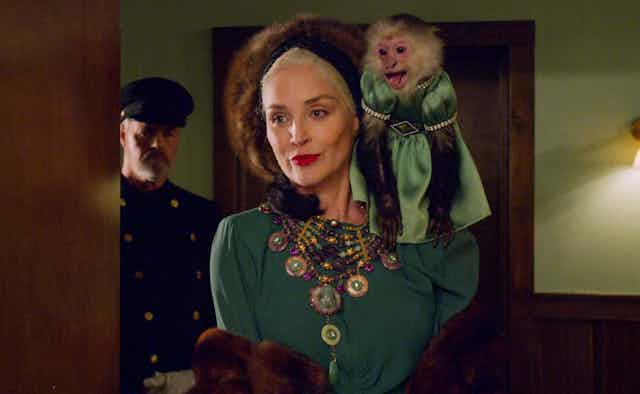Meryl Streep once commented that when a woman in Hollywood turns 50, the only roles left for them to play are “gorgons or dragons or in some way grotesque”. That may well be true, but – as Sharon Stone is demonstrating as Lenore Osgood in the hit Netflix series Ratched – these “invisible” older women are coming to the fore in a range of “Gothic” roles.
Ratched is the most-watched series on Netflix in 2020. It’s essentially an origin story for the 1975 film One Flew Over the Cuckoo’s Nest, directed by Milos Forman and based on the 1962 novel by Ken Kesey. In the movie, Mildred Ratched is a sadistic nurse at a mental institution who mistreats her patients. The Netflix series tells the story of her developing sadism over years.
In the series, Sharon Stone plays the glamorous Lenore Osgood, a former showgirl (according to Stone’s back story for the character) characterised in one review as “a Norma Desmond-like eccentric heiress out for revenge”. This reference to Norma Desmond is no coincidence. Her role is a self-aware homage to the faded star that was seared into the popular imagination by Gloria Swanson’s performance as Norma Desmond in Sunset Boulevard (1950).
So the character of Osgood is the latest in a rich seam of roles that can be traced back via the likes of Bette Davis and Joan Crawford in What Ever Happened to Baby Jane? That of talented and versatile actresses past what would normally be considered to be Hollywood’s “use-by” date, finding success by playing “faded star” roles.

The series American Horror Story has also been a fertile source of roles for Hollywood stars of a similar vintage to Stone. Jessica Lange, Kathy Bates and Angela Bassett have played leading roles in various episodes, demonstrating the continued visibility of ageing women on screen in roles that showcase their talent and experience.
Hollywood’s fixation with youth and beauty (in its women, of course) is a well-established field of study. According to UK film scholar Christine Gledhill, this is rooted in the rise of the showgirl-turned-movie star in the 1920s and the subsequent preference for young, beautiful women on screen. So, for example, both Davis and Crawford dominated romantic drama and noir with Oscar-winning performances in the 1930s and 1940s. Davis won Best Actress for her roles in Dangerous and Jezebel, while Crawford won for her role in Mildred Pierce.
In her study of ageing and stardom, US film scholar Emily Carman notes that after world war two, with the return of servicemen en masse to US cinemas, producers saw the appeal of younger female stars such as Marilyn Monroe, Audrey Hepburn and Grace Kelly who began to push their older colleagues into the sidelines.
Gothic glory
Through familiar conventions of Gothic literature including decaying mansions, madness and doppelgängers, the faded star film originated by Sunset Boulevard made the ageing actress into an explicitly Gothic figure. This role has given actresses from Swanson to Stone the platform to interrogate Hollywood’s ageist misogyny by satirically reclaiming their own “faded” status. The Gothic’s unsettling nature and celebration of the monstrous outsider plays a crucial role in enabling the ageing actress to break such boundaries.
These films are often regarded as inaugurating the “hagsploitation” genre, an insensitive brand of horror centred around deranged older women. This misleading term oversimplifies the purpose of these films and neglects the agency of the actresses. Far from being an empty horror trope or a misogynistic caricature, the faded star is a feminist reclamation of the ageing female body.

This is best demonstrated in the making of What Ever Happened to Baby Jane? because Davis and Crawford used this film to take control of their careers. Crawford pushed for the director Robert Aldrich to cast her in a new film with Davis as her co-star. Davis played up the grotesquery of Baby Jane for artistic merit, which earned her an Oscar nomination. Without the star power of both actresses, the film would not have been financed by Seven Arts Productions.
Women to the fore
This legacy is coming to the fore in several “Gothic” series, of which Ratched and American Horror Story are prominent examples. Lange has won several awards for her leading roles in American Horror Story, all of which reflect on her own faded stardom through characters that grapple with lost celebrity status, including failed actresses in Murder House and Freak Show, a former nightclub singer in Asylum and a fading beauty in Coven.
Meanwhile Bates, who won a best actress Oscar for her portrayal of a deranged book lover (Misery 1990) has played a range of Gothic roles in American Horror Story as part of the show’s ensemble cast.
Actresses are also producing their own Gothic shows. Dubbed as “Female Gothic”, the HBO series Big Little Lies, the creation of Reese Witherspoon’s production company, Hello Sunshine, has provided challenging roles for herself, Nicole Kidman, Laura Dern and Meryl Streep.
In light of these recent examples, it’s time to reconsider the negative “hagsploitation” label that is often attached to Gothic roles as leading actresses continue to confront our assumptions about women, ageing and success.

